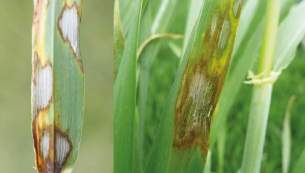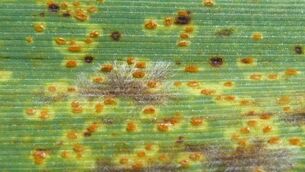Ramularia Leaf Spot
Ramularia collo-cygni
Ramularia leaf spot (Ramularia collo-cygni) is a common disease of barley which can result in significant yield loss if not controlled. While both winter and spring planted barley can be affected, the impact of Ramularia is
usually greater on winter planted crops. Ramularia is seed borne and once the fungus has infected the plant it grows within the plant, not producing visible symptoms until around ear emergence. Symptoms consist of small brown lesions which under the right conditions can rapidly increase and coalesce together.

Initial symptoms of Ramularia leaf spot (RLS) are small brown spots. These then develop into larger, reddish-brown lesions, which can have a yellow margin. RLS lesions penetrate through the leaf. Symptoms can develop very rapidly when conditions are favourable.
Look out for:
- Small, brown spots
- Larger, reddish-brown lesions
Risk factors:
- Infected seeds
- Barley stubble
- Spring rainfall
- High light intensity following flowering
RLS has a complex life cycle starting with infected seed. (None of the available seed treatments control RLS). The disease then grows unseen within the plant before it causes symptoms, usually after barley flowers.
If trash from a previous barley crop is present spores from this source can infect a crop during the season.
Spring rainfall and also periods of high light intensity following flowering favour RLS.
Yield losses of 20% have been recorded.















